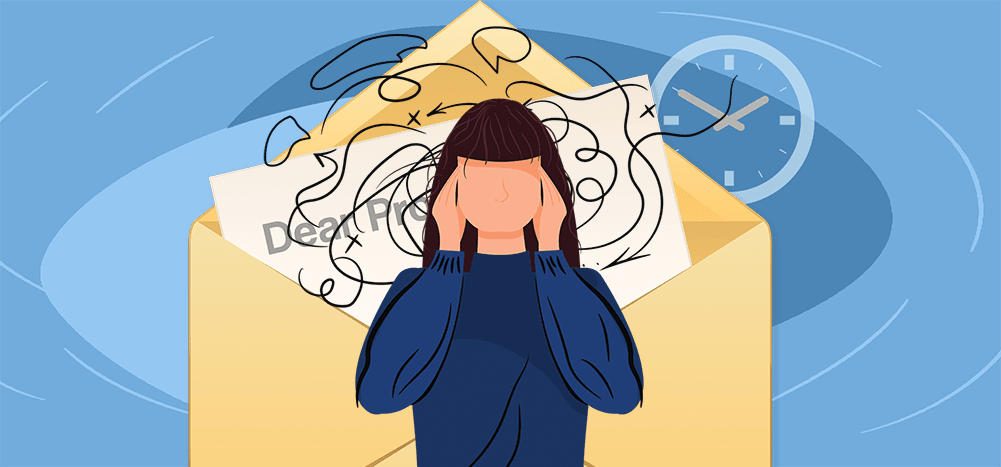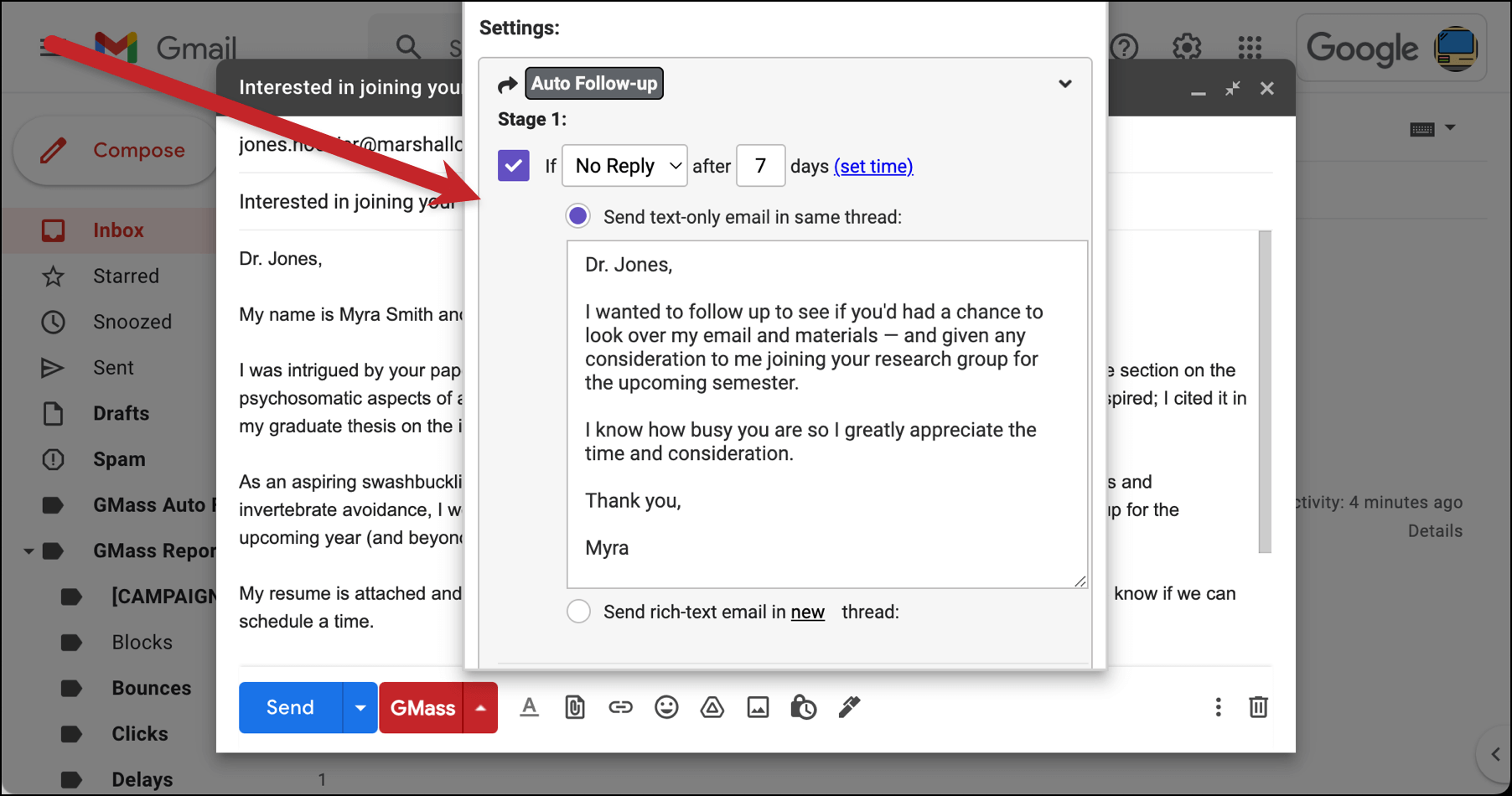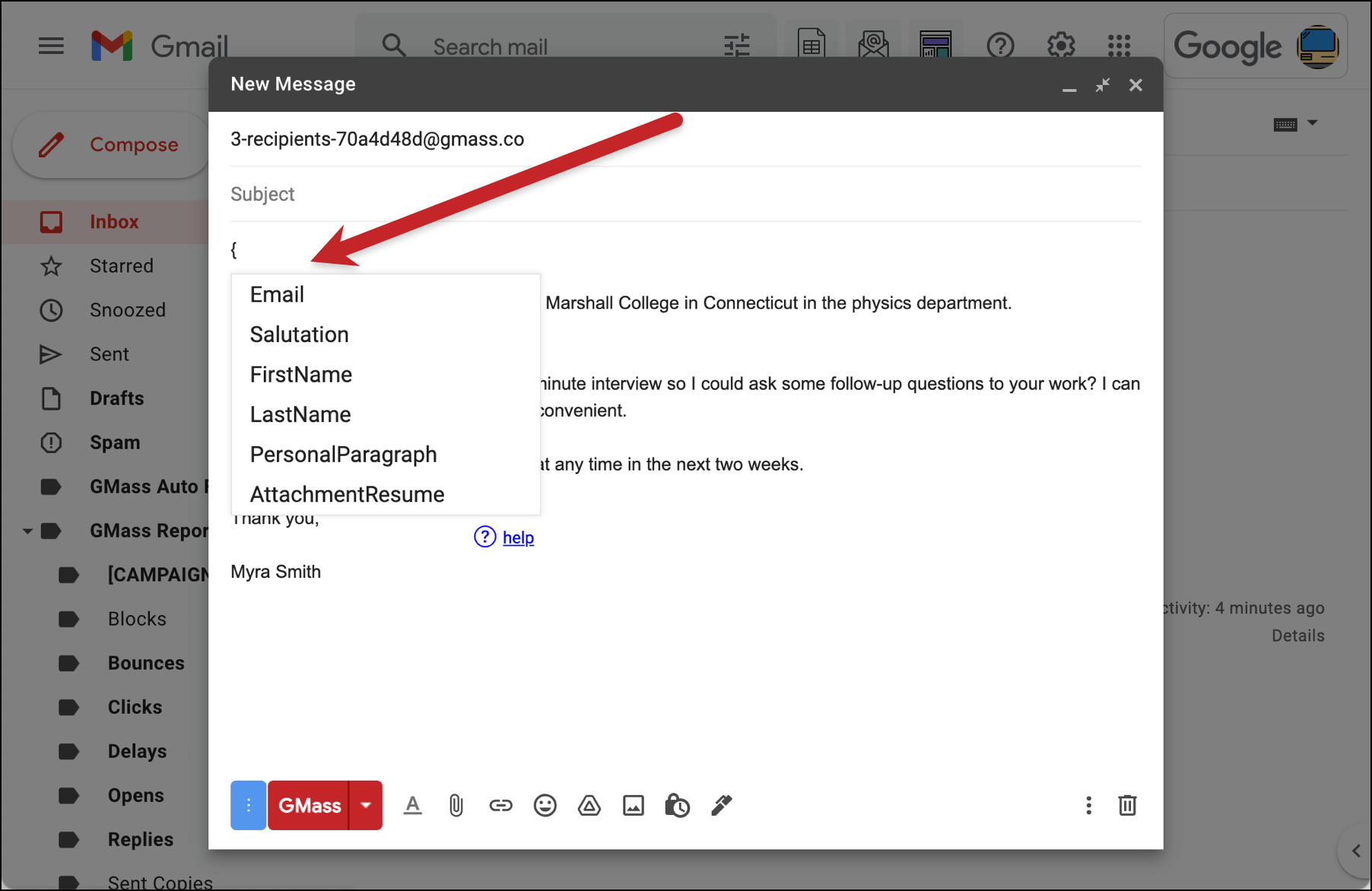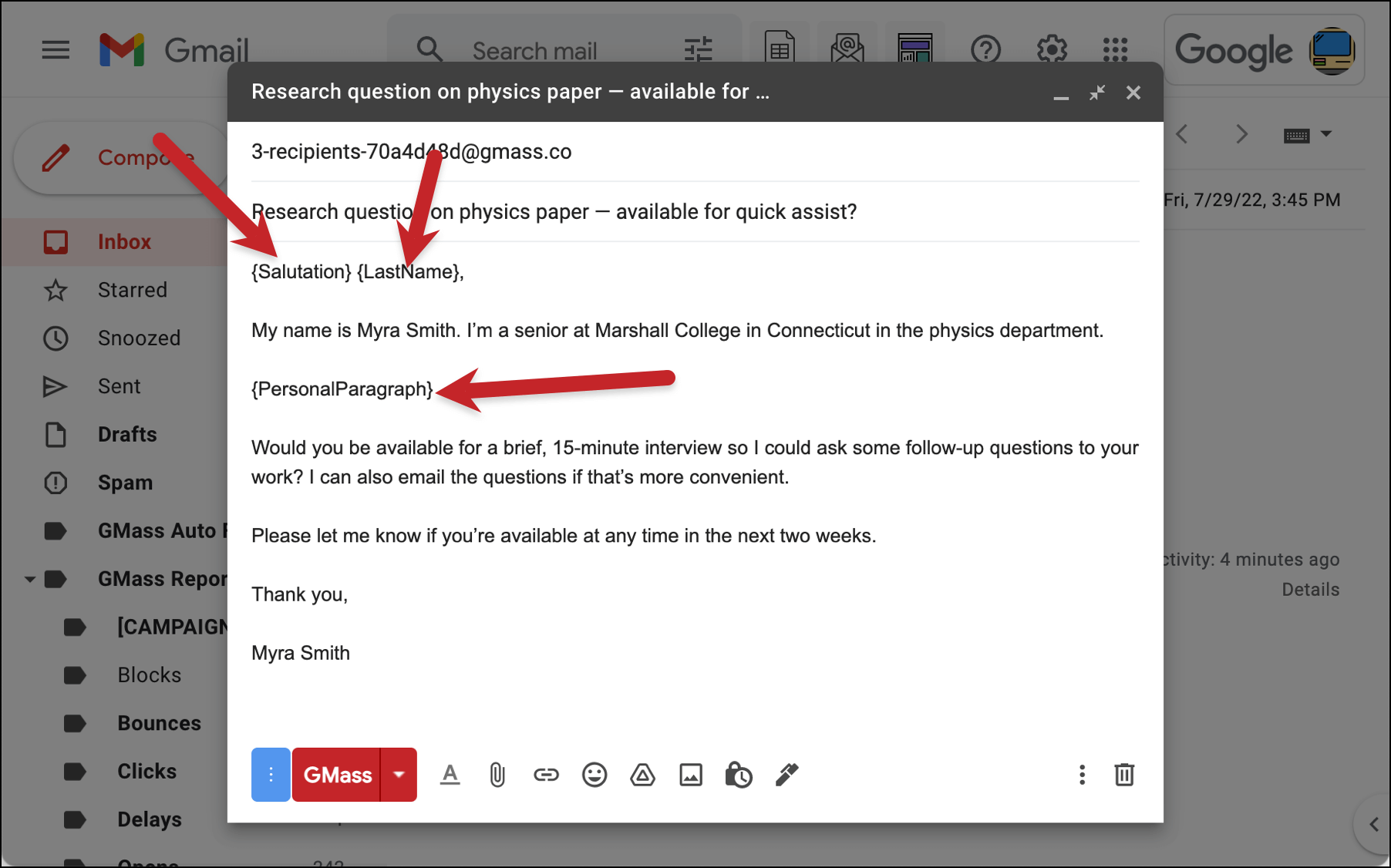
There are moments throughout your college career where you’ll need to cold email a professor. If your college experience is anything like mine, most of those moments will be at two in the morning when you’re in an all-out panic. And you won’t have time to outline, write, edit, and re-write those emails making sure they’re phrased in the perfect way.
In this article, we’ll cover everything you need to know about cold emailing professors, lecturers, TAs, and other teachers and instructors.
We’ll go over strategies (we’ve spoken with several students, professors, and experts to learn the best techniques) and give examples and templates for specific types of emails to professors.
One note before we jump in. Please adapt these templates and make them your own. Don’t use them word-for-word. Impersonal emails never work.
We hope this makes your future 2:00 A.M. meltdowns go a whole lot smoother.
How to Email a Professor: Table of Contents
- 13 Strategies When You’re Cold Emailing a Professor
- Templates for Cold Emails to Professors
- How to Set Up These Personalized Cold Emails (and More) in GMass
- How to Email a Professor: Conclusion and Takeaways
13 Strategies When You’re Cold Emailing a Professor
Need to cold email a professor? That means: Emailing a professor with a request when that professor likely has no idea who you are.
We’ll cover some specific examples later in this article but to give you a base, here are general tips for cold emailing a professor.
Fundamental tips for sending a cold email to a professor
Use an informative subject line
Your subject line should make it clear what you’re emailing about. And if you can personalize the subject line, that’s even better.
Keep it tight
Professors don’t want to read essays. (Unless they’ve assigned essays for a midterm. And even then, I’m not sure they’re dying to read them.)
Keep your messages tight — three to four short paragraphs is best.
Make it highly personalized
I can’t say this loud enough: Generic mass cold emails won’t work. You need to tailor your message to the professor.
For instance, if you want to join their research group, cite their work that resonates with you, how it ties into your area of study, and the unique or valuable perspective you can bring to it.
Personalization here needs to go beyond, “I read your paper on articulated robots and found it interesting.” Show you really dug in and found some insight from their work.
Generally, if you’re going to cold email a professor, go for something less generic than “I noticed on your website that one of your interests is Machine Learning”.
— Zachary Lipton (@zacharylipton) November 17, 2018
Dr. Monica Malta, a researcher and professor at the University of Toronto, suggests taking it even further. One of Dr. Malta’s top trainees came from a cold email.
“They knew what I was working on, not only by reading my professional page, but also by following me on Twitter, where I’m quite active. And they were specific about what they were looking for as an internship, what qualifications they had, what they wanted to learn… this trainee did their internship and continued to a master’s degree with me.”
Sell yourself without sending a full autobiography
You have three sentences at most to (1) introduce yourself (2) sell yourself and (3) make it clear how you’re different than all the other people cold emailing this professor and, therefore, worthy of their time. Accomplishing all that is going to take effort… and lots of editing and re-writing.
Get the details right
Get the professor’s title right. (Dr.? Professor?) Make sure your email is typo-free, you demonstrate a full understanding of what the professor does, and your request is relevant to their work.
Olumuyiwa Igbalajobi, Ph.D., a mycologist at the University of British Columbia, stresses the importance of accuracy in his work with students on their cold emailing. “Read that email over and over again,” he says, “Before you press the send button.”
Don’t email a professor when you’re on a tight deadline for their response
If you email a professor something to the effect of: “I have a paper due tomorrow on [topic], can you please send me your research and answer these five questions?” you will not hear back.
Even if the professor has time they won’t be inclined to reward your irresponsibility.
Follow up if you don’t hear back
You don’t want to follow up too soon or too aggressively… but you should follow up.
Send a follow-up email about a week to two weeks after your initial email. If you still haven’t heard back after that and you’re determined to make this work, you could try visiting the professor during their office hours. Or… take the hint and move on to your next contact.
Advanced strategies for sending a cold email to a professor
Don’t email two professors from the same department at the same time with the same request
Professors in the same department are more likely to talk to one another than professors in different departments or different schools. If they figure out you’ve emailed both of them, suddenly your personalized request doesn’t feel so sincere.
Also, you should probably limit your cold emails to two professors in the same department total.
Flattery can work… if it feels sincere
Flattery is an art. If your flattery is coming from a genuine place, that will shine through. If you tell the professor a minor detail in a report they wrote 10 years ago changed your life… that’s less believable.
Your goal is to adequately praise the professor’s work without coming off as insincere or too sycophantic.
The basic principle of enticing any Professor when sending cold email is this:
‘Everyone likes to be quoted’
Once you understand this, you are good.
— Oludayo Sokunbi (Deewon) (@Oludeewon) September 16, 2021
Warm up the cold lead by talking with other students already working with the professor
If you’re looking to join a professor’s lab or research group, contact the other undergrad or graduate students in that group. Pick their brains on what the professor is looking for and what messages might resonate.
Schedule your email for the right time
What’s the best time to email a professor? Early-ish in the morning so they get the email as they start their work day.
Also, avoid sending big requests when professors are busy around midterm and final time (if the professor teaches classes).
Important points to remember while emailing:
1. Schedule your email so that it reaches them before their office hours (around 8 AM their time zone)
2. Use the correct salutation (Dr./Mr./Miss etc.) @OpenAcademics @PhDfriendSana @hapyresearchers
— Graduate School Counsellor📚🏫✈️ (@sjay_yayy) August 8, 2021
Warm up with a different request
If you have time to play the long game, you can establish a relationship with a cold email with a light request… then, down the road, send a warmer email with your big request.
This trick will make a professor respond to your cold email https://t.co/xIaUz9A5nm
— Muneer Yaqub🇺🇸🇳🇬 (@elMunir5) May 24, 2022
For example, you could email a professor now telling them you’re citing their research in a paper you’re writing. Ask a clarification question, ask for a quote, ask if they can send you a copy — any low-lift request.
Now, when you reach out in a few months about joining their research group, you can cite your prior interaction.
Dr. Malta agrees with the slower approach. “If, by any chances, you met this person at a cocktail party, how would you approach? You probably wouldn’t just walk up and start pitching them, right? … You might try to connect with this person, either by mentioning a shared friend or interest, and later you could make your pitch.”
How to end an email to a professor
It’s easy to overthink the end of your email. Make sure you end with a thank you — for their time and their consideration. Avoid saying “Thanks in advance” — that’s too presumptive.
“Finish with something nice,” Dr. Malta says, “If it’s appropriate, mention that you understand that their schedule is busy, assuring that they can reply when they have time.”
As for your “last word,” you can use “Regards,” “Sincerely,” “Thank you,” or anything else formal or semi-formal. (So as much as you want to end with “Keep it real,” resist the urge.)
Templates for Cold Emails to Professors
How to email a professor about joining a research group or lab
An email to a professor about joining a group needs to accomplish a lot of things in only a few paragraphs. You need to introduce yourself, demonstrate deep understanding and admiration for the professor/group’s work, show why you’re qualified to join and would be an asset, and give a call-to-action.
It should also trend toward a formal tone without being too stilted or unnatural.
Here’s a sample.
Template for joining a research group
Dr. Jones,
My name is Myra Smith and I’m a first-year graduate student in the archaeology program.
I was intrigued by your paper on the contravening impact of reptiles in the antiquities retrieval process. The section on the psychosomatic aspects of an archaeologist’s anathema toward snakes was particularly compelling and inspired; I cited it in my graduate thesis on the intersection of biology and archaeology.
As an aspiring swashbuckling archeologist with an academic specialization on mythical religious antiquities and invertebrate avoidance, I would appreciate an opportunity to talk with you about joining your research group for the upcoming year (and beyond).
My resume is attached and I am available for a chat in person, on Zoom, or over the phone. Please let me know if we can schedule a time.
Regards,
Myra Smith
Why the template to join a research group works
Here’s what this template does:
- Opens with the correct title (Dr. in this case).
- Has a quick introduction of the sender.
- Includes a brief discussion of the professor’s work. It shows the student has read and understood the work (and, in this case, even cited it).
- Gives the student’s credentials. It shows the professor why the student would be an asset to the group.
- Includes a call-to-action to reply.
Email to ask for thesis advisor or dissertation chair
The process of reaching out to a thesis advisor has some similarities to the research group email. You still need to introduce yourself properly and demonstrate a deep and specific knowledge of the professor’s work.
You should also include your thesis focus. Figure out the best way to present it so it intrigues the professor and is academically stimulating to them without giving it all away or going into too much detail — that will draw them in.
Template for asking for an advisor
Dr. Jones,
My name is Myra Smith. I’m a junior here at Marshall College in the archaeology department.
Your research, in particular your work on the lost ark of the covenant, was the inspiration for the direction I’ve taken with my archaeology studies. The examination of facial liquefaction was particularly transformative.
I am currently beginning work on my thesis on mythical religious antiquities. In particular, I’ve found myself focusing on artifacts guarded by the Knights Templar. Are you currently accepting students for thesis advisory? Based on your expertise and academic focus this partnership feels like the perfect fit for my work.
Please let me know if we can schedule a time to discuss further.
Thank you,
Myra Smith
Why this template to a potential advisor works
This template:
- Keeps everything brief.
- Opens with a quick introduction.
- Shows an understanding and admiration for the professor’s work. You shouldn’t say they were an “inspiration” unless they genuinely were; however, citing specifics in their work is important.
- Offers enough information about the student’s thesis to make it clear it’s a new and interesting topic — but leaves it just vague enough to spark the professor’s curiosity.
- Gives a respectful call-to-action.
Email to a professor for research assistance
Sometimes you may need to contact a professor for assistance with a research project.
In some ways, this cold email is a smaller ask than the others: You’re not asking to join their group or bring them on as an advisor, just for some research help. But in other ways, it’s a bigger ask: Research groups and advisory are defined parts of their job, sending info to a random student isn’t.
You need to make a compelling case why you’re reaching out to them. You also need to set a strategic deadline — you don’t want to seem irresponsible with a deadline that’s too soon, but also don’t want them to forget with a deadline too far off.
Template for asking for research assistance
Dr. Jones,
My name is Myra Smith. I’m a senior at Marshall College in Connecticut in the physics department.
I’m currently working on a report on the physics of the whip which I plan to submit to multiple journals. In my research I found your paper “The Versatility of the Whip: Weapon, Swing Assistant, or Artifact Retrieval?” Your empirical whip experience in all three facets is unique, to say the least, and your insight would be invaluable.
Would you be available for a brief, 15-minute interview so I could ask some follow-up questions to your work? I can also email the questions if that’s more convenient.
Please let me know if you’re available at any time in the next two weeks.
Thank you,
Myra Smith
Why this template for research assistance works
Here’s why this template works:
- The student introduces themself in a succinct manner.
- The email cites the professor’s relevant work and makes it clear why the student is specifically reaching out to them.
- The student keeps the request for time brief and convenient.
- The student sets a strategic deadline without being pushy.
How to ask a professor for a letter of recommendation via email
A letter of recommendation request isn’t a true cold email — after all, the professor should know who you are if you’re asking them for the letter.
However, this is a cold request — in that they aren’t expecting it and it’s adding work to their plate.
A good letter of recommendation email will “re-introduce” you by covering your history with the professor, jogging their memory about your relationship. It will explain why you need the letter of recommendation. And it will set a reasonable deadline — much like the research request above, a deadline that’s not too soon but not too far away.
Template for asking for a letter of recommendation
Dear Dr. Jones,
It’s Myra Smith from Archaeology 504: Making Your Comeback by Searching for Alien Artifacts. The course has been fascinating, of course, much like the other two courses I’ve taken with you in the past.
I was hoping based on my work in the class and our conversations during your office hours (in particular our hour-long chat on crystal skulls) you could write a recommendation letter for me.
As you can see from my attached resume, I’m planning to apply for jobs for procurement at museums all around the world. I know a recommendation from you carries a tremendous amount of weight and would be invaluable as I begin my career.
Please let me know if you’ll have availability to write the letter sometime in the next few weeks. I’m planning to begin applying in October. I’d also be happy to come by during your office hours to discuss this further.
Thank you,
Myra Smith
Why this letter of recommendation request works
This request does a lot in only four paragraphs.
- It re-introduces the student and jogs the professor’s memory on their experience together.
- It lays out why the student needs the recommendation.
- It uses flattery, but the flattery is genuine.
- It sets a reasonable deadline that shows the student isn’t operating last minute… but that there’s some sense of urgency.
- It makes things easy on the professor, as the student offers to come to office hours as a follow-up.
How to Set Up These Personalized Cold Emails (and More) in GMass
Now that we’ve covered the strategies and templates, I’m going to walk you through setting up these emails in GMass.
GMass is a cold email platform that works directly inside of Gmail or Google Workspace — no external app required.
Even though, in many cases, you’ll be sending these emails one at a time, you can (and should) still use GMass’s features like tracking, automated follow-ups, and scheduling.
And if you are sending emails to multiple professors at once, GMass’s Google Sheets integration should make that process even easier. With GMass, you’ll be able to personalize the emails at scale.
Download and connect to GMass
Get started with GMass for free by downloading the Chrome extension from the Chrome Web Store. On the GMass free plan you can send up to 50 emails in a day. That should more than cover your needs here.
Our only ask: Based on our thousands of reviews, after you see GMass in action, you’ll realize there are so, so many ways you can use it in your future academic life and professional life. So please remember GMass when you’re ready to upgrade to a paid plan (or team plan) with a higher sending limit.
It should only take a minute or two to download GMass and connect it to your Gmail or Google Workspace account. For step-by-step instructions, our quickstart guide will walk you through.
Compose your email
Open a Gmail compose window and type up your cold email — just like you’d type any other email.
Schedule, follow-ups, and tracking
Click the small arrow next to the red GMass button to bring up the settings for this email campaign. (Even though it’s a single email, we’ll still call it a “campaign.”)
Open and click tracking
Open and click tracking are both turned on by default. If you want to turn them off for whatever reason, uncheck the boxes. GMass will track replies and bounces regardless.
Scheduling the email
Click into the Schedule section of the settings.
Use the dropdown menu next to “Time” to set the date and time for the email. (First thing in the morning is the recommendation.)
Set up an automated follow-up
You can use GMass to set up an automated follow-up — one that will only go out if the professor doesn’t reply to your initial email.
Click into the Auto Follow-up section of the settings.
Check the box under Stage 1. Then set the auto follow-up to go out If No Reply after 7 days. That means this follow-up message will go out after one week if the professor hasn’t replied.
Type your message in the box. I kept it brief, polite, and formal in this example.
Sending a test, then sending the email
You can test the email (and the follow-up sequence) with GMass.
At the top of the settings box, click the arrow next to the purple Send Test button. Then check the box next to “Send all stages” — that will send you the entire sequence.
Now click the Send Test button and check your inbox for a test version of the email.
As you can see, the follow-up will come as a reply to the prior email. That simulates how you’d send the email if you were doing this process manually, not automated.
Check and double-check your emails to make sure everything looks right, there are no typos, you’ve remembered to attach what you said was attached, and you’re happy with what you’ve written.
Once you’re satisfied with the email, return to your draft and hit the red GMass button to send. (Or, if you’ve scheduled the email for some time in the future, to queue the email to go out at the designated time.)
Re-using this template in the future
If things don’t work out with this professor, you can quickly re-use this email (and its follow-up) with GMass’s template feature.
GMass turns any email you send into a template you can re-use with one click.
To use a past GMass campaign as the template for a new campaign, open a new Gmail compose window and head into the GMass settings.
Click on the dropdown under Templates.
Then select your prior email from the list.
GMass will automatically fill in the old template in the compose window. Your settings and auto follow-up(s) will also carry over. Now you can edit this email to send to the next professor.
Sending multiple cold emails at scale with GMass
The how-to guide above works for sending a single email to a single professor. But what if you need to email multiple professors?
You can set that up in GMass — and use mail merge to make sure every email is properly personalized.
Set up a Google Sheet
Set up a Google Sheet with the professors’ info. In my sample here, I included columns for email, salutation, first name, last name, an entire personalized paragraph about their research and my connection to that research, and a link to a PDF of my research tailored toward their specialty.
Connect the Google Sheet to GMass
In Gmail, click the spreadsheet icon next to the Gmail search box. Then connect to this Google Sheet. (You will need to give GMass permissions to access your Google Drive files the first time.)
Compose your email
The Gmail compose window will come up once you’ve connected your spreadsheet.
You can use mail merge tags to fill in the data from your Google Sheet. Type a left curly brace { and you’ll see a list of your column headers — which are now the merge tags for your email.
Here’s my email with the merge tags.
Personalized attachments
You can send personalized attachments with these emails by putting links to those attachments in your Google Sheet. GMass will “download” the file from that link and attach it to the proper email when you send.
It’s a great way to add things like a tailored resume, cover letter, research findings, or other information.
Create drafts
When you’re dealing with sensitive information in a mail merge, you may want to review each email before you send it. You can do that with GMass’s drafts feature.
In the GMass settings, click “Create Drafts” under Action.
GMass will create a draft of each personalized message. You can find them in your Gmail drafts folder, then either send them or delete them (to edit the email or your Google Sheet).
How to Email a Professor: Conclusion and Takeaways
Cold emailing professors isn’t easy — and it’s natural to feel all sorts of anxiety right before and right after you send.
But cold email is a fantastic way to connect and communicate — and to work with the professors you most want to work with.
You (almost certainly) won’t have a 100% success rate. But if you can avoid taking that personally, you stick with cold email, and you keep refining and improving the messages you send — you will get results.
We hope GMass can be a huge asset for you in the cold email process. Whether you’re sending a cold email to one professor or a whole list, GMass adds cold email features directly inside Gmail which can improve every step of the process.
Download GMass from the Chrome Web Store to get started. And try it out for free — you can send up to 50 emails per day during your free trial period.
Send incredible emails & automations and avoid the spam folder — all in one powerful but easy-to-learn tool
TRY GMASS FOR FREE
Download Chrome extension - 30 second install!
No credit card required













